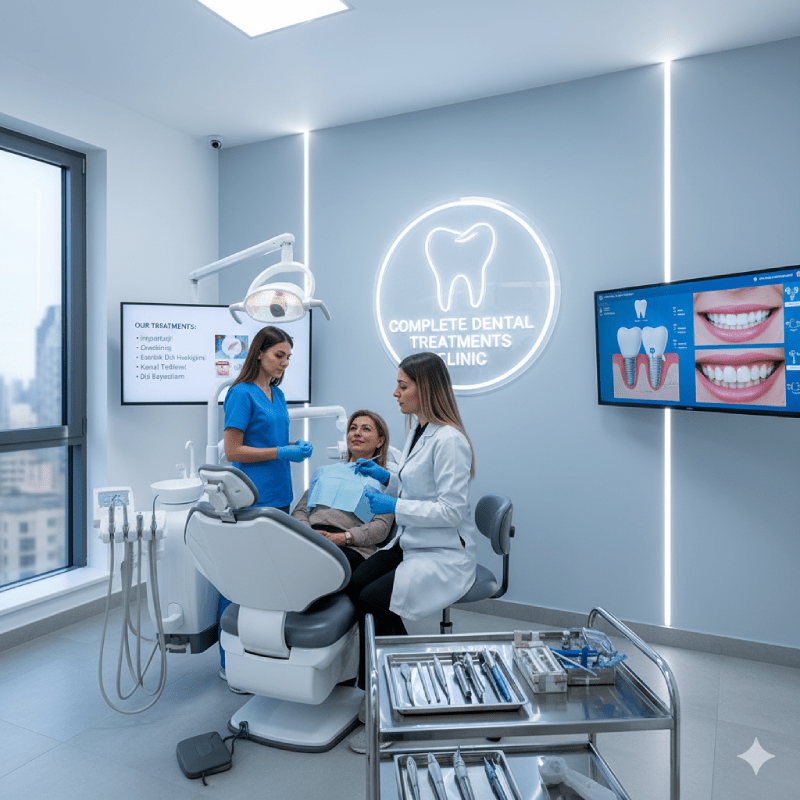What Is A Dental Bridge and What Does It Do?
A dental bridge is a fixed dental prosthesis used to replace one or more missing teeth. It gets its name from bridging the gap created by missing teeth by connecting to natural teeth or implants on either side. The main function of a bridge is to restore lost chewing function and aesthetic appearance. This structure prevents neighboring teeth from shifting into the empty space, balances chewing pressure, and prevents the collapse of the facial structure. In this way, both your oral health is protected, and you can smile with confidence.
What Are The Main Parts of a Dental Bridge?
A dental bridge is fundamentally composed of three main parts: the abutment teeth, the bridge footing, and the pontic. Abutment teeth are the neighboring natural teeth that the bridge is supported by and are typically covered with crowns. The bridge footing is the structure that sits on the abutment teeth and secures the bridge. The pontic is the artificial tooth that fills the gap from the missing tooth. The harmonious function of these three components guarantees the bridge’s strength and functionality. Cure Holiday experts design each of these components with the best materials and with the utmost precision.
What Is The Main Purpose Of A Dental Bridge?
The main purpose of a dental bridge is to solve both the functional and aesthetic problems caused by one or more missing teeth. A missing tooth gap can lead to problems such as difficulty chewing, speech impediments, and other teeth shifting. The bridge fills this gap, distributing chewing force evenly, preventing the dental alignment from deteriorating, and helping to preserve the facial structure. As a result, it allows patients to eat more comfortably, speak more clearly, and have a more aesthetic smile.
What Is a Traditional Dental Bridge And How Is It Applied?
A traditional dental bridge is the most commonly used type. The healthy teeth on either side of the missing tooth gap are reduced so they can be covered with crowns, allowing the bridge to sit stably. This procedure is called “tooth preparation.” Then, the custom-made bridge, prepared in a lab, is permanently cemented onto these prepared teeth. This method provides strong support and securely fills the space of the missing tooth.
What Is a Maryland Dental Bridge and What Is Its Difference?
A Maryland dental bridge, unlike traditional bridges, does not require the trimming of neighboring teeth. The pontic (artificial tooth) is bonded to the back surfaces of the adjacent teeth using wing-like metal or porcelain extensions. This method is a minimally invasive solution as it preserves the tooth structure. However, it may not be as durable against chewing forces as a traditional bridge. For this reason, it is generally preferred for front teeth or in areas where the chewing force is low.
How Does An Implant-Supported Dental Bridge Work?
An implant-supported dental bridge is built on dental implants placed in the jawbone to replace missing teeth. This method preserves healthy teeth as it does not require trimming neighboring natural teeth to support the bridge. Implants function just like natural tooth roots, providing an extremely strong and permanent foundation for the bridge. Implant-supported bridges offer high stability and longevity, making them an ideal option, especially in cases where multiple teeth are missing.
How Many Appointments Does Dental Bridge Treatment Require?
Dental bridge treatment is usually completed in two or three appointments. In the first appointment, the abutment teeth are prepared, and impressions are taken. These impressions are used for the custom fabrication of the bridge in the lab. In the second appointment, a temporary bridge may be placed. In the final appointment, a few weeks later, the permanent bridge prepared in the lab is placed, and its fit is checked. This process can vary depending on the complexity and the dentist’s plan.
Is Pain Felt During Dental Bridge Treatment?
During dental bridge treatment, pain is generally not felt because a local anesthetic is applied. Your dentist will take all necessary precautions to ensure you feel comfortable while preparing the abutment teeth or placing the bridge. After the procedure, there may be some mild sensitivity or pain. This condition usually subsides on its own within a few days. If the pain persists, it can be managed with over-the-counter painkillers.
What Materials Are Used In Dental Bridge Fabrication?
Dental bridges can be made from various materials. The most commonly used are porcelain-fused-to-metal, zirconium, and full porcelain. Porcelain-fused-to-metal bridges offer durability and cost-effectiveness. Full porcelain bridges provide a more natural and transparent appearance as they contain no metal. Zirconium bridges are among the most modern options, offering a combination of aesthetics and durability. The choice of material depends on factors such as aesthetic expectations and chewing force.
How Are Teeth Prepared During The Dental Bridge Procedure?
During a traditional dental bridge procedure, the neighboring teeth that will support the bridge are prepared. This process involves the minimal reduction and shaping of the tooth’s surface. This allows the bridge to fit onto the teeth snugly and securely. Your dentist is extremely careful to avoid damaging the tooth’s nerve tissue during the preparation. This procedure is of critical importance for the bridge’s stability and longevity.

Is A Dental Bridge A Better Option Than An Implant?
The comparison between a dental bridge and an implant varies on a case-by-case basis, as both treatments have their unique advantages and disadvantages. Bridges are a great option for patients who need a quicker solution or are not suitable for implant surgery. However, they require the trimming of healthy neighboring teeth. Implants, on the other hand, preserve healthy teeth and prevent jawbone resorption. Both methods are successful, and you should have a detailed consultation with your dentist to determine the best option for you. Cure Holiday experts will offer you the best option tailored to your needs.
How Long Does Dental Bridge Treatment Take?
Dental bridge treatment is a process that typically takes a few weeks, from the first appointment to the final permanent placement. It begins with the preparation of the teeth and taking impressions during the initial consultation. The bridge is then prepared in a lab based on these impressions. This period can take a few days. In the second appointment, the bridge is placed, and final checks are made. The duration of this process depends on the complexity of the treatment and the lab’s working speed.
What Sensations Are Experienced After Dental Bridge Placement?
After dental bridge placement, you may experience some mild sensitivity or a strange sensation for the first few days. It’s normal for your teeth to adapt to a new structure. You may feel a slight difference while chewing, but this sensation will quickly disappear. If you experience pain, discomfort, or an issue while biting, it’s important to contact your dentist immediately. These symptoms may indicate that the bridge needs an adjustment.
Is Dental Bridge Care Difficult?
Dental bridge care requires a little more attention than regular dental care. Cleaning the gaps under the bridge is important to prevent plaque buildup and the formation of cavities. Your dentist will show you how to clean under the bridge with tools like a special floss or an interdental brush. Regular brushing and flossing are the most important ways to maintain the health of your bridge and abutment teeth.
Do Dental Bridges Cause Bad Breath?
If a dental bridge is not cleaned correctly, it can cause bad breath. Food particles and bacterial plaque that accumulate in the gaps and edges under the bridge can produce foul-smelling gases. To prevent this, you should regularly brush your bridge and abutment teeth and use special cleaning tools to clean under the bridge. A proper hygiene routine prevents bad breath.
How Long Does It Take to Get a Dental Bridge?
The process of getting a dental bridge is generally completed within a week. The first appointment is for the preparation of the teeth and taking impressions. The bridge is then prepared in the lab, which takes a few days. In the final appointment, the bridge is placed, and a perfect fit is ensured. Cure Holiday uses modern technologies to complete this process as quickly as possible and with the highest quality.
What Is The Lifespan Of A Dental Bridge?
The lifespan of a dental bridge varies depending on the quality of the material used, the patient’s oral hygiene, and regular dental check-ups. On average, a dental bridge can last between 5 and 15 years. However, with a high-quality material, proper application, and meticulous care, this period can extend up to 20 years. Regular dental visits help you prolong the life of your bridge.
What Determines The Cost Of Dental Bridges?
The cost of dental bridges varies depending on the type of material used (porcelain, zirconium), the number of missing teeth, any additional treatment requirements (like root canals), and the dentist’s experience. More durable and aesthetic materials like zirconium are more costly than porcelain-fused-to-metal bridges. For the most accurate pricing and a personalized treatment plan, it’s best to consult with one of Cure Holiday’s specialists.
Which Teeth Are Prepared For A Dental Bridge?
For a dental bridge, the natural and strong teeth located on either side of the missing tooth gap are prepared as “abutments.” These teeth serve as the main support for the bridge’s stability. The dentist minimally reduces the surface of these teeth so that the bridge can fit onto them perfectly. This ensures the bridge is securely placed and shows durability against chewing forces.
Who Is Suitable For Dental Bridge Treatment?
Dental bridge treatment is suitable for individuals with one or more missing teeth who have healthy abutment teeth on both sides of the gap. It is also an excellent alternative for patients who are not suitable for implant treatment due to conditions like gum disease or insufficient bone structure. Your dentist will determine the most suitable treatment method for you after a detailed examination.
When Can I Eat After Dental Bridge Placement?
You can consume normal foods even after a temporary bridge is placed, but it is recommended to avoid very hard or sticky foods. After the permanent bridge is placed, you can usually return to your normal diet within a few hours. Your dentist may give you specific recommendations to adjust chewing pressure.
How Does A Dental Bridge Affect Speech?
A dental bridge can help correct speech impediments caused by missing teeth. The absence of front teeth, in particular, can make the proper pronunciation of certain sounds (like s, z, and t) difficult. The dental bridge fills these gaps, allowing the tongue to be in the correct position and enabling sounds to be produced clearly. This makes the patient’s speech more fluid and understandable.
Is Getting A Dental Bridge Beneficial For My Oral Health?
Yes, getting a dental bridge is very beneficial for your oral health. It prevents problems such as other teeth shifting, dental alignment deterioration, and chewing issues caused by missing teeth. It also distributes chewing force evenly, reducing the pressure on the jaw joint. This helps to protect your jaw health in the long run.
Does A Dental Bridge Look Natural Aesthetically?
Modern dental bridges provide highly successful aesthetic results. Materials like zirconium and full porcelain, in particular, have the ability to reflect light just like natural teeth. Your dentist will custom-design the color, shape, and size of the bridge to match your neighboring teeth. This ensures that your bridge is not noticeable in your mouth and you have a natural-looking smile.
What Should Be Done If A Dental Bridge Cracks Or Breaks?
If you notice a crack or fracture in your dental bridge, you should consult your dentist immediately. While small cracks can sometimes be repaired, large fractures usually require the bridge to be completely replaced. Continuing to use a broken bridge can harm the abutment teeth and lead to oral health problems.
How Is A Dental Bridge Cleaned and Cared For?
Regular brushing and flossing are essential for dental bridge care. You should also use a special floss (super floss) or a water flosser to clean under the bridge. These tools clean plaque and food particles from hard-to-reach areas under the bridge. Regular dental check-ups help to maintain the health of your bridge and abutment teeth.

Which Materials Are Better For A Dental Bridge?
The best material for a dental bridge depends on your personal needs and aesthetic expectations. Zirconium is one of the most popular options due to its high durability and natural appearance. Full porcelain bridges offer excellent aesthetics as they contain no metal. Your dentist will evaluate your situation to determine the most suitable material for you.
What Are The Risks After Dental Bridge Treatment?
One of the most important risks of dental bridge treatment is the decay or gum disease of the teeth supporting the bridge. Additionally, a poorly made bridge can cause chewing problems or pain. To minimize these risks, it’s important to choose an experienced dentist and follow a regular oral hygiene routine. At Cure Holiday, we work with an expert team to minimize these risks.
Can A Dental Bridge Become Loose?
A properly bonded dental bridge does not easily become loose or fall out. However, the bridge can become loose due to reasons such as decay in the abutment teeth, gum recession, or a severe trauma. If you feel that your bridge is loose, you should consult your dentist immediately, as this can harm the teeth underneath.
When Should A Dental Bridge Be Replaced?
A dental bridge should generally be replaced after 5 to 15 years. The need for replacement arises in situations such as a crack or fracture in the bridge material, decay of the abutment teeth, or a large gap forming under the bridge. Regular dental check-ups allow you to detect this need early.
How To Maintain Oral Hygiene With A Dental Bridge?
Maintaining oral hygiene with a dental bridge requires special effort. In addition to regular brushing and flossing, it is recommended to use a special floss or a water flosser to clean the gaps under the bridge. These tools clean food particles and bacteria from areas that a normal toothbrush cannot reach.
What Is The Relationship Between A Dental Bridge and Gum Health?
There is a direct relationship between a dental bridge and gum health. If the area under the bridge is not cleaned adequately, plaque buildup can cause gum inflammation and gum recession. The deterioration of gum health can lead to the bridge becoming loose and falling out. Therefore, regular care and hygiene are of critical importance for the success of your bridge.
What Is The Fabrication Process For A Dental Bridge?
The fabrication process for a dental bridge begins with an initial examination and consultation. Then, the abutment teeth are prepared, and impressions are taken. These impressions are sent to a lab to create a custom-made bridge. At this stage, a temporary bridge may be placed for the patient’s comfort. Finally, the permanent bridge prepared in the lab is placed in the mouth, and final adjustments are made for a perfect fit.
How Does Getting A Dental Bridge Affect My Quality Of Life?
Getting a dental bridge can significantly improve your quality of life. It eliminates the chewing, speech, and aesthetic problems caused by missing teeth, giving you the opportunity to smile with confidence and feel comfortable in social settings. Additionally, a healthy chewing function improves digestion and contributes to your overall health.
Who Should I Consult If I Have Questions About Dental Bridges?
For any questions you may have about dental bridges or other dental treatments, Cure Holiday specialists are always ready to help you. You can contact us to create a personalized treatment plan and to clear up any questions you have.



